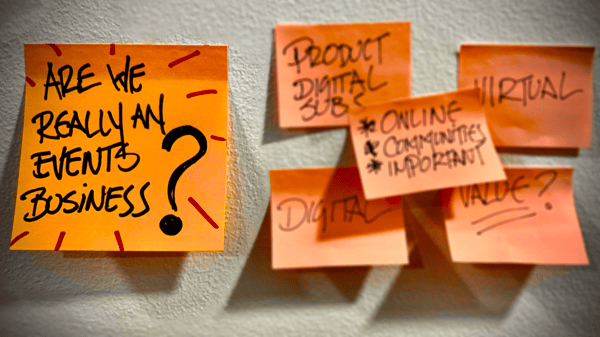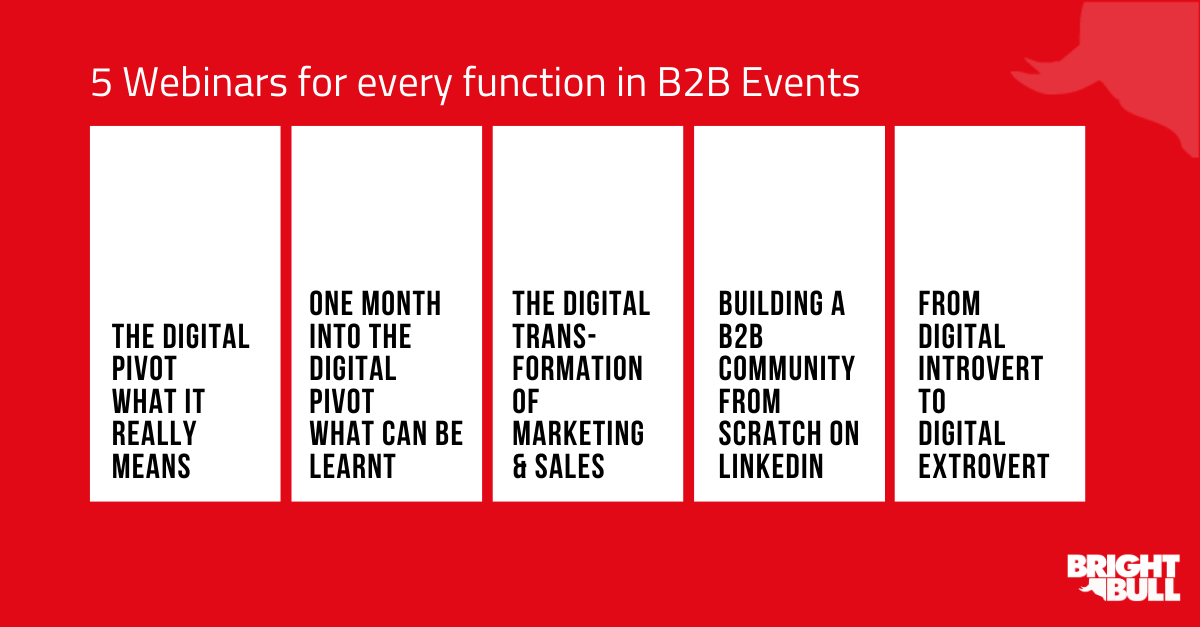This is a long post and has tips / methods / videos / interviews all revolving around the Digital Pivot for Events.
Jump to the place you see fit:
What is the context around the Digital Pivot?
No one really knows when this global situation will end and what it will look like when it does.
People shouldn't presume that once lockdowns in different parts of the world are lifted, things will revert to the corporate and individual behaviour we were used to - both in the events world and the business world at large.
With all this uncertainty it will be very naive to think your event will be back to normal in Q4, H1 or H2 2021. So what will the new normal be?
Some event business leaders have gone against the current and are taking this time to truly understand their audiences and determine what is the real value their business is creating, specifically outside the walls of a physical event.
This has led them to drive/try various initiatives and models to mitigate the consequences of the current situation: Online Communities, an always ON business, content portals, virtual events, hybrid events etc.
Then there's sub-group of leaders going much deeper... perhaps even philosophical.
- Are we really an events business at all?
- Do we even serve the events industry?
- Do we want to continue as an events business?
It's not just about events anymore ... it's about a new business model that focuses on true value, connection and shared knowledge. A new mindset.

The Digital Pivot: What it really means? and how you can go about it.
It is not about virtual events, although it is part of it; it is not about giving your postponed event clients and audiences free inventory and content, although you should.
The "Digital Pivot" for B2B Events is a real and very serious discussion about the business model pivot to deliver the QUALITY and VALUE your audiences and clients expect and need, online, distributed across time and formats.
Julian Graves and the team at Collingwood Advisory have been working with media, events, subscriptions and data entrepreneurs on strategy, scaleup, value creation and exit planning since 2006.
Below are excerpts of an interview and candid discussion specifically relevant for B2B event leaders and how they can navigate their current pivoting strategies.
Collingwood's 3 stages approach plus key takeaways from Julian's session.
If you want to review the full interview you can access it on demand here.
As we will come to find there are a host of approaches and models companies can explore. The Collingwood Advisory team sees the transition for B2B event organisations in three stages:
Mitigation
- In response to your audience and clients, companies will need to mitigate the impact of the current situation and protect the revenue/commitments already made
- Deeply understand your audience, their needs and seek to meet those needs digitally
- Create your digital alternatives (whatever they might be)
- Both your audience and clients will either value / appreciate what you have done or not
Habituation
- Analyse your audience's response to what you have done
- Learn: What works, what doesn’t, how to report, how to delivering things brilliantly
- Deliver more of what worked, fix/bin what didn't
- Seek to habituate them to your new value proposition
Acceleration
- Go after your competitors who have not been able to do this as efficient and agile as you have done
BrightBull's key highlights for all event leaders
|
A month into the digital pivot - The good and the bad of running a virtual event - from those that went to market first.
After a couple of months into this pandemic, what is the perspective and results from those that have gone through this process? and what does business look like?
In this session, we had three guests who have run very recent virtual events and very successfully.
1. White October Events and their LeadDev Live event
White October Events run a really cool community for Lead Developers. It's a fresh and forward-thinking event business and they run very successful live events in London, New York, San Francisco and Berlin.
Their events range between 600-1,500 attendees and the moment they decided to pivot their NY LeadDev Live event to virtual they received over 12,000 registrations.
Flume Sales Training and their "Selling in a Crisis" Webinar Series
The crew at Flume did not have any virtual offering pre-COVID19. But the current circumstance led them to pivot and create a virtual webinar series, including free sessions as well as paid for workshops, to stay top of mind and support their audience with value add content.
Their webinar sessions received unprecedented results with over 2,600 sign ups.
Collingwood Advisory and various cases using their Digital Pivot framework/thinking process
The team from Collingwood Advisory work with forward thinking leaders in events, media and subscription services companies. They are probably one of the most reputable and knowledgeable advisory service for our industry. Fergus Gregory shares a couple of cases that are currently undergoing their digital pivot and are following their digital pivot framework.
Events businessess and digital media businesses might be assuming that their most important people in the room are their "paying clients" but the reality is that the most important people are "the client's customers."
Knowingly or unknowingly business leaders that are taking action are following a process, one that has led them to success."
Top questions asked:
Do you need to vary the formats across the one event?
What are the best practices for engaging an audience in virtual B2B events
What are the top 3 requirements from a B2B Virtual Events platform you would advise us to look for?
What is the best advise from those that have done it?10 Key Points B2B Business Leaders need to think about when looking at their digital pivot offering1. Speak to your audience - Find out what’s keeping them awake at night right now, and work out why you are best placed to offer them a solution. 2. Get testing - An agile approach is going to help you stay ahead of your competition. Try something, see what works, iterate on what doesn’t. Don't get wedded to a single idea and foster a culture of feedback and iteration. 3. Look after your team - Without your team, you don’t have a business. Keep them as safe, happy and healthy as you can and celebrate the small wins. Everyone needs different support right now, but they will all appreciate clarity and openness from the leadership team. Make that your priority. 4. This is product development on steroids - As senior leaders you have to get much closer to your customers now to make this a success. 5. Focus on your audience first - Focus on your audience first, build a clear content and inventory value proposition based on your core personas, their industry and functional pain points 6. One customer/sponsor at a time - Build a customer-by-customer plan - focused on fulfilling liabilities, then upsell, then new business 7. Grow share of wallet and market share faster and with more certainty - Advise your customers and prospects what will work, deliver it, then show them that it worked - again and again. 8. Know why your clients need you to exist - Know why your clients need you to exist, this will help you gain 100% clarity of purpose. 9. Focus on the why and how - Audience behaviour and message before platform 10. Shift perspective - Create and redefine audience and client personas |
Finally
If you have already pivoted one or various of your events, well done, you are probably in the process of evaluating what worked and what didn't. You should also be working very closely with your clients to habituate them to your new way of working.
If you are still looking at what works best for you, good for you as you probably didn't (or don't ) have the pressure of time. It's likely that you've spent the time wisely getting to know your customer personas better and learning from the mistakes of others.
It is time to take action, and I hope that in this post you've found at least one or two valuable action points and some structure to help you through your planning and thought process.
If you liked what you've read, join one of these sessions live or on demand!

